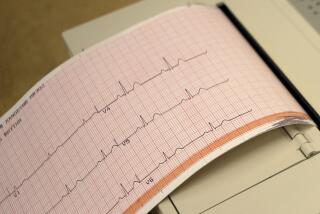Use of imaging tests soars, raising questions on radiation risk
The use of CTs, MRIs and other advanced medical imaging tests has soared over the last 15 years, according to new research that raises questions about whether the benefits of all these scans outweigh the potential risks from radiation exposure and costs to the healthcare system.
An examination of data from patients enrolled in six large health maintenance organizations found that doctors ordered CT scans at a rate of 149 tests per 1,000 patients in 2010, nearly triple the rate of 52 scans per 1,000 patients in 1996. MRI use nearly quadrupled during the period, jumping from 17 to 65 tests per 1,000 patients, according to results published in Wednesday’s edition of the Journal of the American Medical Assn.
These and other tests have meant that more patients have absorbed more ionizing radiation as part of their medical care. The proportion of patients in the study who had any amount of radiation exposure — driven by the use of CTs — rose from 28.5% in 1996 to 36.2% in 2010; among them, their average exposure jumped from 4.8 millisieverts to 7.8 millisieverts. At the top end of the spectrum, the proportion of patients in the study who got radiation at high or very high levels rose from 1.8% to 3.9%.
“We’ve become victims of our own technology,” said Dr. George Bisset, chief of pediatric radiology at Texas Children’s Hospital in Houston and president of the Radiological Society of North America.
Advances in imaging technology have allowed doctors to peer inside the body with striking resolution. Computed tomography, or CT, scans combine a series of X-rays into a detailed three-dimensional image. Magnetic resonance imaging machines detect energy emitted by hydrogen atoms in the body and convert that into pictures. Both tests can reveal blockages in arteries, bleeding in the brain, tumors and other life-threatening conditions.
Although MRIs do not use ionizing radiation, CTs do, and that can damage the DNA in cells and lead to mutations that cause cancer. A number of recent studies have linked increases in medical imaging to higher rates of radiation-induced cancers, including a report last week in Lancet that showed a correlation between CT scans in children and their subsequent risk of developing brain tumors or leukemia.
And both kinds of tests are expensive. Advanced imaging adds about $100 billion to U.S. medical bills each year, said study leader Rebecca Smith-Bindman, a radiologist and epidemiologist at UC San Francisco.
There is widespread agreement in the medical community that imaging tests are overutilized, particularly CT scans. In April, the American Board of Internal Medicine released a report that asked doctors from numerous medical specialties to list five procedures they felt were used too much. All of the doctors — including cardiologists, oncologists and family physicians — listed CT scans among their top five.
Researchers have already charted similar growth in advanced imaging in fee-for-service medical systems, where doctors may have a financial incentive to order tests that aren’t really necessary.
The JAMA report is the first large study to focus on imaging use in HMOs. The findings suggest that profit-seeking on the part of doctors is not the primary cause of the increase in testing.
“In the fee-for-service world, there are enormous incentives to do more testing because it’s a very profitable part of healthcare,” said Smith-Bindman, the study leader. “But in these HMOs, the healthcare system doesn’t really get any direct financial gains from these tests.”
Smith-Bindman offered other explanations for the increase in testing, including unrealistic expectations about the ability of CTs and MRIs to show what is wrong with a patient and doctors’ fear that if they don’t order the tests, they will miss something that could lead to a lawsuit.
“For many scenarios, deciding to image is an absolute slam dunk,” she said. “But we need to get away from the default approach of, ‘Oh, let’s just image.’ ”
Bisset, who wasn’t involved in the study, said patient and physician expectations were also to blame.
“We don’t have any tolerance for diagnostic uncertainty anymore,” he said. “Patients want answers, they want them fast, and the less invasive the test, the better.”
Experts said they were most concerned by the growth in CT use documented in the study. The researchers found that 2.5% of the patients in the six HMOs were exposed to between 20 and 50 millisieverts of radiation in 2010, a level that the International Commission on Radiological Protection says is unsafe. Another 1.4% of the patients were exposed to more than 50 millisieverts of radiation that year, which the U.S. Nuclear Regulatory Commission says is dangerous.
In an editorial that accompanied the study, two physicians wrote that these high doses should prompt doctors to consider the radiation risks of the tests they order and discuss those risks with their patients.
Physicians are not required to inform patients in writing about the radiation risks of CTs. But Dr. Richard Semelka, director of MRI services at the University of North Carolina at Chapel Hill, said the time had come for that to change.
“It should be abundantly clear by now that ionizing radiation does carry with it the risk of cancer,” said Semelka, who wasn’t involved in the study. “It just seems so obvious that we should be providing patients with the risks even if we don’t have the exact numbers.”






